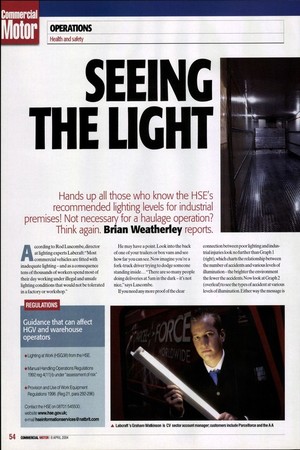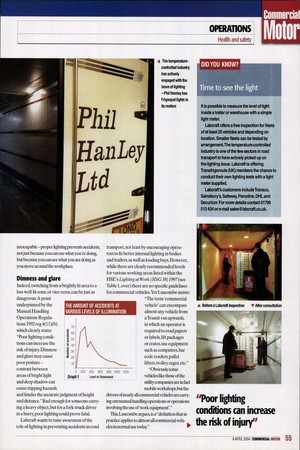SEEING THE LIGHT
Page 54

Page 55

Page 56

If you've noticed an error in this article please click here to report it so we can fix it.
Hands up all those who know the HSE's recommended lighting levels for industrial
premises! Not necessary for a haulage operation?
Think again. Brian Weatherley reports.
According to Rod Luscombe, director at lighting experts Labcraft:"Most commercial vehicles are fitted with inadequate lighting — and as a consequence tens of thousands of workers spend most of their day working under illegal and unsafe lighting conditions that would not be tolerated in a factory or workshop."
He may have a point. Look into the back of one of your trailers or box vans and see how far you can see. Now imagine you're a fork-truck driver trying to dodge someone standing inside... "There are so many people doing deliveries at 5am in the dark — it's not nice," says Luscombe. If you need any more proof of the clear connection between poor lighting and industrial injuries look no further than Graph 1 (right),which charts the relationship between the number of accidents and various levels of illumination—the brighter the environment the fewer the accidents. Now look at Graph 2 (overleaf) to see the types of accident at various levels of illumination. Either way the message is
inescapable -proper lighting prevents accidents, not just because you can see what you're doing, but because you can see what you are doing as you move around the workplace. Dimness and glare Indeed, switching from a brightly lit area to a less well-lit zone, or vice versa, can be just as dangerous.A point underpinned by the Manual Handling Operations Regulations 1992 reg 4(11)(b) which clearly states "Poor lighting conditions can increase the risk of injury Dimness and glare may cause poor posture contrast between areas of bright light and deep shadow can cause tripping hazards
and hinder the accurate judgment of height and distance." Bad enough for someone carrying a heavy object, but for a fork-truck driver in a hurry, poor lighting could prove fatal. Labcraft wants to raise awareness of the role of lighting in preventing accidents in road transport, not least by encouraging operators to fit better internal lighting in bodies and trailers, as well as loading bays. However, while there are clearly recommended levels for various working areas listed within the HSE's Lighting at Work (HSG 38) 1997 (see Table 1, over) there are no specific guidelines for commercial vehicles.Yet Luscombe insists:
"The term 'commercial vehicle' can encompass almost any vehicle from a Transit van upwards, in which an operator is required to read papers or labels, lift packages or crates, use equipment such as computers, bar code readers, pallet lifters, trolley cages, etc." "Obviously some vehicles like those of the utility companies are in fact mobile workshops;but the
drivers of nearly all commercial vehicles are carrying out manual handling operations or operations involvingthe use of 'work equipment'."
This,Luscombe argues,is a"defmition that in practice applies to almost all commercial vehicles in normal use today."
In other words the cargo carrying areas within a truck or a trailer body along with loading docks and parking bays should be judged against the existing HSE lighting recommendations, especially when it comes to avoiding glare and ensuring uniform lighting over the working area.
And that's not all. Luscombe says both the manual handling and use of work equipment regulations (and it's difficult to see the use of a truck or trailer not coming within the category of 'work equipment') refer specifically to the need for "suitable... and sufficient light" and that lighting "should be adequate for the needs of the task..."
What is 'sufficient'? But what exactly is "sufficient" and how do you know whether your lighting meets the recommendations? The good news is that Lab-craft is able to test a trailer
interior or loading bay for you and provide a confidential report on any shortfall against the HSE recommendations. The results from checks so far in the haulage industry are not encouraging. "In four years we have not found a commercial vehicle that met the minimum recommendation — and most were far below," says Luscombe. "The industry as a whole is completely unaware that any regulations exist that might apply and
that the problem can be easily solved."
Speaking at a recentTransfrigoroute (UK) health and safety seminar, Luscombe told the audience that although operators are often alerted to the issue of poor lighting by drivers, or because old-fashioned lighting has failed, "the usual response is to replace bulbs and perhaps specify more lights, which rarely solves the problem and can lead to battery problems".
The answer, Luscombe believes, is to switch to more modern, effective lighting equipment.
"Most vehicles are currently lit inside by conventional lights with one or two incandescent bulbs at a 21 watt rating. However, light levels can be increased between five to six times by installing properly designed fluorescents in the right places." Less glare While the cost of a combined halogen/ fluorescent interior light unit for a reefer trailer is around £25 compared with £5 for a standard incandescent light, Luscombe maintains that the benefits include less
glare and power usage, lower maintenance and downtime (the tube lasts 10 times longer), improved efficiency in loading and above all else greater safety as they are certified to HSE standards. For an average semitrailer Luscombe says around four or five per trailer are needed. This might sound a lot, but compared with a major personal injury claim caused by poor workplace illumination it could work out considerably cheaper to start shining some light on the problem. •
It is possible to measure the level of light inside a trailer or warehouse with a simple light meter.
Labcraft offers a free inspection for fleets of at least 20 vehicles and depending on location. Smaller fleets can be tested by arrangement.The temperature-controlled industry is one of the few sectors in road transport to have actively picked up on the lighting issue. Labcraft is offering Transfrigoroute (UK) members the chance to conduct their own lighting tests with a light meter supplied.
Labcraft's customers includeTransco, Sainsbury's, Safeway, Parceline. DHL and Securicor. For more details contact 01799 513 434 or e-mail sales@labcraft.co.uk.
Guidance that can affect HGV and warehouse operators
• Lighting at Work (HSG38) from the HSE. • Manual Handling Operations Regulations 1992 reg 4(11) b under "assessment of risk" • Provision and Use of Work Equipment Regulations 1998. (Reg 21, para 292-296) Contact the HSE on 08701545500, website www.hse.gov.uk; e-mail hseinformationservices@natbrit.com






































































































